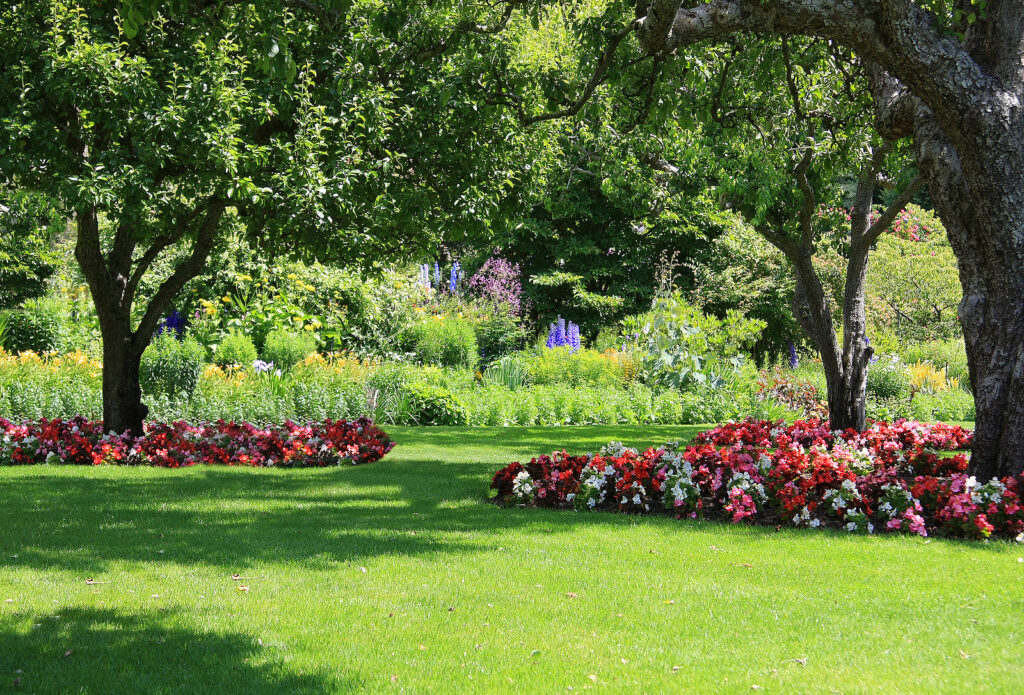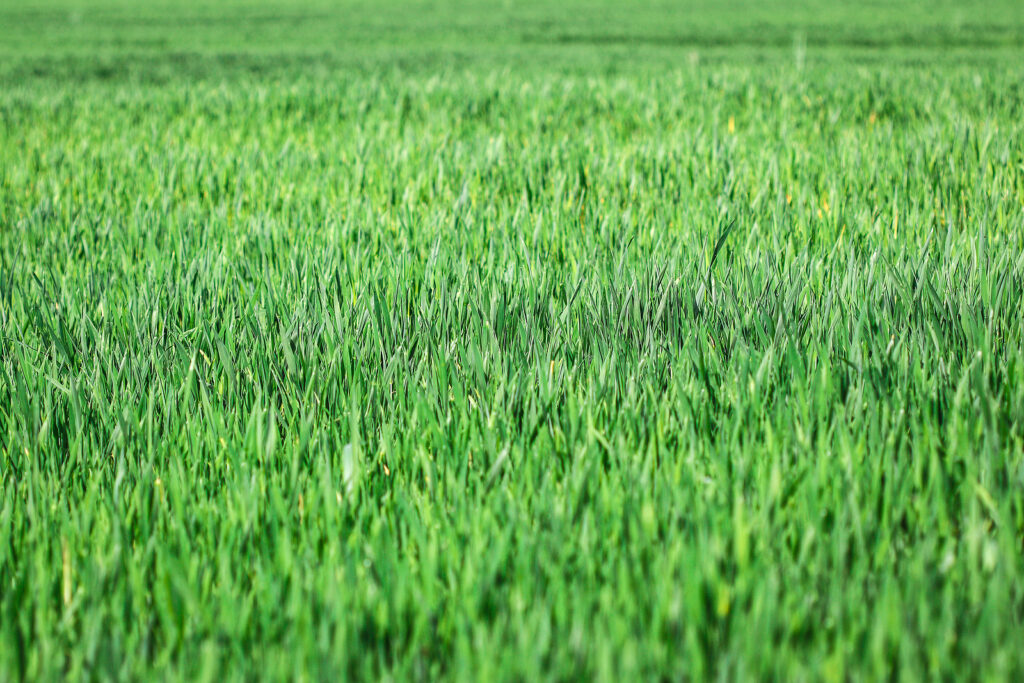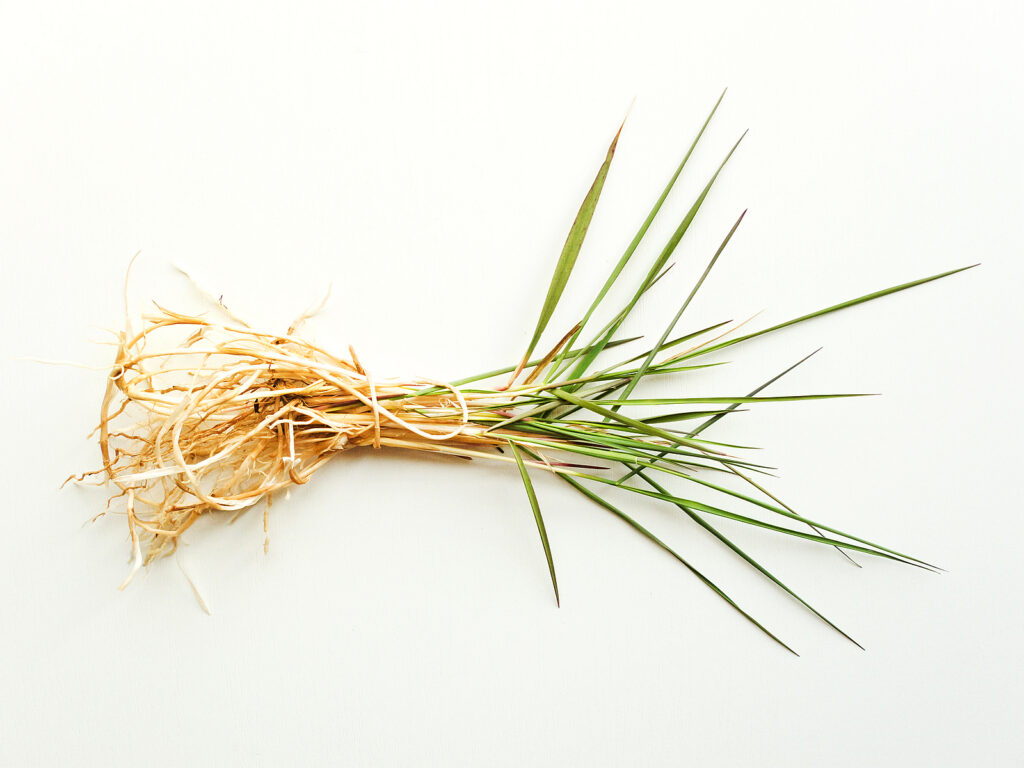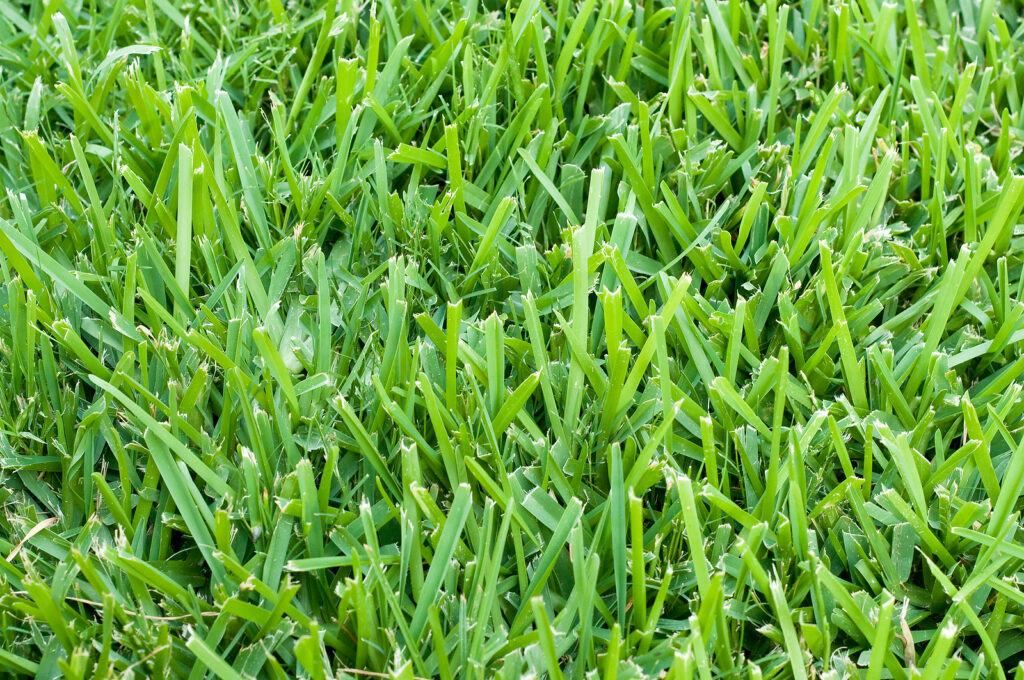The ideal lawn grass is disease-free, shade tolerant, drought-tolerant, and wear-resistant. That lawn grass does not exist. There is no one all-purpose grass.
Nearly all lawns are mixtures of four or five grasses or varieties. Lawn seed mixtures allow for variations in season and temperature as the year progresses. While one, two, or three grass varieties in a mix thrive, one or two in the mix may suffer or fail as temperature, water, and light vary from month to month.
You should research the best lawn grasses for your area. There are several factors to consider when choosing the best lawn grass for your yard.

Things to consider when choosing a lawn grass
Here are important areas of consideration when choosing a lawn grass:
- Cold or Mild Winters: Choose cool-season grasses where temperatures freeze in winter. Choose warm-season grasses where winter temperatures are mild and seldom freeze.
- Sun or Shade: Lawn grasses naturally grow in sunlight. Most lawn grasses want full sun, a few are bred to grow in bright shade (a few hours of sunlight each day). Use a shade-tolerant grass if your yard is shady for more than half of the day.
- Foot Traffic: Choose a sturdy grass for heavy foot traffic or play areas; sturdy varieties include perennial rye, tall fescue, Bermudagrass, Bahiagrass, or zoysia.
- Salt-Tolerance Near the Ocean: In northern regions, the cool-season fescues tolerate salty air, in southern regions St. Augustine grass tolerates salty air.
- Soil Conditions: Bahia grass grows in sandy, infertile soil; Buffalograss grows in heavy clay soil and is drought tolerant from western Louisiana, north-central Texas, eastern Colorado to western Kansas, Nebraska, and Oklahoma. For acidic soil plant, Canada bluegrass, chewings fescue, and hard fescue. For alkaline soil, plant perennial ryegrass, wheatgrass, and Bermudagrass.
- Invasive Grasses: Bermudagrass spreads horizontally; use edging to keep it from spreading into flower beds.

Annual and perennial grasses
Lawn grasses can be annuals, perennials, or a blend of the two.
- Annual grasses germinate quickly—adding color to the lawn quickly. They live for one growing season. Annual ryegrass is the best known annual grass; it provides excellent cover in autumn, winter, and early spring.
- Perennial grasses grow larger and lusher over the years. They live for several years. Perennial grasses are the fundamental components of nearly all lawns. Perennial lawn grasses include perennial ryegrass, Kentucky bluegrass, and fescue.
Bunching and creeping grasses
Grasses can be bunching or creeping.
- Bunchgrasses are named for their bunchy appearance caused by the production of many tiller from the crown of the plant. These grasses expand only by tillering—a tiller is a grass shoot that grows from the stem the parent grass shoot growing from the grass seed. Common bunch-type grasses are annual ryegrass, hard fescue, perennial ryegrass, some varieties of red fescue, and tall fescue.
- Creeping grasses are named for their creeping growth habit. These grasses spread by horizontal roots called stolons or rhizomes that “creep” along the ground. Stolons are on top of the ground and rhizomes are under the ground with new plants growing out of these “runners”. Grasses that spread by rhizomes are Kentucky bluegrass and some varieties of Red fescue. Grasses that spread by stolons are buffalo grass, creeping bentgrass, rough bluegrass, and St. Augustine grass. Grasses that spread by both stolons and rhizomes are Bermuda grass, Colonial bentgrass, Kikuyugrass, Seashore paspalum, and Zoysia grass.

Fine-textured and coarse-textured grasses
- Fine-textured grasses create a smooth-looking refined lawn. They are soft underfoot and comfortable for children to play on. Fine grasses include creeping red bentgrass, Kentucky bluegrass, Bermuda grass, and zoysia grass.
- Coarse-textured grasses have wide blades; they are tough and drought tolerant. They include tall fescue, buffalo grass, and some varieties of perennial ryegrass.
Cool-season and warm-season grasses
There are two main lawn grass categories: cool-season and warm-season.
Cool-season grasses are best for regions where temperatures drop below freezing during the winter months. Cool-season grasses grow best in spring and fall and go dormant in winter and during hot, dry summer weather.
Warm-season grasses are best for mild climates of the southern third of the country. They go dormant and turn brown in winter.
About cool-season lawn grasses
Cool-season grasses do best in cool temperatures of spring and fall. They include fine fescues, tall fescues, Kentucky bluegrass, perennial ryegrass, and rough bluegrass. In warm climates, these grasses look good year-round as long as they have ample water.
- Fescues: There are two types of fescue: fine-textured (Fesutca rubra) and hard or coarse-textured (Festuca longifolia). Fine-textured fescues have a soft appearance and deep green color. Coarse-textured fescues grow fast, are wear-resistant, and drought-resistant. Coarse-textured fescues are not as attractive as fine-textured fescues and may tend to clump over time. Fine-textured fescue varieties include ‘Creeping Red’, ‘Illahee’, ‘Rainier’, and ‘Chewings’. Coarse-textured varieties include ‘Meadow’, ‘Alta’, ‘Kentucky 31’, and ‘Goars’. Tall fescue (Festuca elatior). Fine-textured fescues are a good choice where summers are cool, such as the coastal Northwest or at higher elevations.
- Kentucky bluegrasses (Poa pratensis). Dark, blue-green color and fine, soft texture. Grow best in moderate-summer regions. Varieties include ‘Kentucky’, ‘Merion Kentucky’, ‘Newport’, ‘C-1’, ‘Windsor’, ‘Delta’, ‘Park’, and Poa trivialis.
- Ryegrasses. Medium-coarse with sparsely-set leaves, fast-growing for a quick cover, adapts to a wide variety of climates. Ryegrass is either perennial or annual; both grow best in coastal regions where winters are mild and summers are cool. Turf-type perennial ryegrasses (Lolium perenne) include ‘Manhattan’ and ‘Pennfine’.

About warm-season lawn grasses
Warm-season grasses grow when the weather is warm—in late spring through summer and into early fall; as a group, they tend to be more heat tolerant. Warm-season grasses include Bahia grass, blue grama grass, buffalo grass, carpet grass, centipede grass, Bermuda grass, St. Augustine grass, and Zoysia grass. In winter they grow brown and dormant and tend to green up later than cool-season grasses.
- Bahia grass (Paspalum natatum). Thrives in sandy soil, takes a lot of foot traffic, and resists insect and disease attacks. Bahia grass grows best in moist soil but can tolerate drought. It can grow in shade and tolerates some salt. A coarse, deep-rooted, wide-bladed Bahia grass variety is ‘Argentine’. Narrow-leaf Bahia grass types are ‘Paraguay’ and ‘Pensacola’; they are a good choice from the central coast of North Carolina to east Texas, including Florida.
- Bentgrass (Agrostis paulstris andspp.). Bentgrass is a perennial cool-season grass that forms a dense mat. It spreads by creeping stolons and has bluish-green thin blades. Bentgrass tolerates poor soil. It needs frequent mowing; tends to develop thatch. It is not a good choice for hot, humid regions.
- Bermuda grass (Cynodon dactylon). Bermuda grass is a fine-textured, golf-course type lawn. It is traffic resistant and somewhat salt resistant but does not tolerate shade. Bermuda grass needs mowing two to three times a week to ½ to 1 inch high. Water Bermuda grass twice a week in sandy soil, water every day in dry weather. It grows best in the South and Southwest. Improved Bermuda grass varieties include ‘Floraturn’, ‘Tifgreen’, ‘Tiflawn’, ‘Everglades No. 1’. Common Bermuda grass is less fine-textured than improved Bermudagrasses.
- Blue grama (Bouteloua gracilis). Blue grama grass is a long-lived warm-season perennial grass native to the plains of North America. It is a short, green or grayish grass that tolerates heat and drought. It’s a good choice in arid regions and alkaline soil.
- Buffalo grass (Buchloe dactyloides). Native American grass. Tolerates heat, cold, drought, and heavy soils.
- Carpet grass (Axonopus) Carpet grass is a low-maintenance, coarse-textured utility grass that grows best in moist, acid soil. It withstands periods of flooding. It is not salt resistant. Mow Carpet grass once a week to 2 inches (5cm) tall during summer to prevent flower spikes. Carpet grass browns in winter.
- Centipede grass (Eremochloa ophiuroides). Coarse-textured grass is easy to maintain. Mow every 10 days to 2 inches high. Grows in southern states.
- St. Augustine grass (Stenotaphrum secundatum). St. Augustine grass is suitable for most soils. It grows well in shade, popular for southern lawns—grown almost exclusively in Gulf Coast states. St. Augustine grass is a coarse texture with a rich appearance. Mow St. Augustine grass every 7 to 10 days to 2 inches (5cm) high. It will remain green in winter in mild regions. Water St. Augustine grass every 7 to 10 days. It is susceptible to brown patch, dollar spot, gray leaf spot, and prone to chinch bug damage.
- Zoysia grass (Zoysia). ‘Emerald’ zoysia grass resembles Bermuda grass in fine texture and color. It is shade and salt tolerant. Zoysia grass grows best in the South but can be grown in the Northeast. Zoysia grass can be slow to fill in and cover. Mow zoysia grass to 1 inch high. Water it every 5 days. Zoysia grass stays green in warm-winter regions. It is susceptible to sod webworm, brown patch, dollar spot, and Bermuda grass invasion.
Lawn grasses that tolerate shade
- Bahia grass: Tolerates partial to light shade
- Centipede grass: Tolerates partial to light shade
- Fine fescue: Tolerates light shade (the most shade tolerant)
- Tall fescue: Tolerates light shade
- St. Augustine grass: Tolerates light shade
- Zoysia grass: Tolerates light shade

Drought-tolerant lawn grasses
- Alkali grass: Drought-tolerant, suitable for desert climates
- Bahia grass: Can tolerate drought; grows best with regular rainfall
- Bermuda grass: Tough and drought tolerant
- Buffalo grass: Once established can get by on as little as 12 inches of water each year
- Centipede grass: Tolerates brief dry spells, but needs water in a drought
- Fine fescue: The species known as hard fescue (Festuca longifolia) is moderately drought-tolerant; fine fescue (F.rubra) and ‘Shademaster’ creeping fescue can also tolerate drought.
- Tall fescue: Moderately drought-tolerant, more so in cooler climates.
- Kentucky bluegrass: Not drought tolerant although some cultivars will hold up dry weather.
- Perennial ryegrass: Moderately drought-tolerant
- Zoysia grass: Drought tolerant
Recommended grasses by begion
Northeast and Upper Midwest
- Bentgrass. Suitable for New York State and the Northeast and north into Canada. Not recommended for the Midwest. Not good in hot, humid regions. Usually mixed with other grasses.
- Buffalo grass. For arid locations in the Upper Midwest. Tolerant of heat, cold, drought, heavy soil. In Upper Plains plant with redtop (Agrostis alba).
- Fine fescue. Tolerates shade and drought.
- Kentucky bluegrass. Most widely planted lawn across the northern two-thirds of the continental United States. Produces thick, lush lawn. Needs watering in dry weather.
- Perennial ryegrass. Germinates quickly and can anchor soil while bluegrass gets established.
- Zoysia grass. Usually grown in the South but recommended for dry parts of the Midwest. Takes time to become established. Tolerated drought and pests. Goes dormant in winter.
Southeast
- Bahia grass. Good in the South, especially coastal locations with poor soil. Low maintenance.
- Bermuda grass. Full sun. Needs less water and fertilizer than many kinds of grass. Prone to thatch buildup. Goes dormant in winter. Overseed with ryegrass in fall.
- Centipede grass. Low maintenance; needs little fertilizing or mowing. Good in acid soil, poor to average fertility. Does not do well in dry climates. Overseed with ryegrass in winter.
- Tall fescue. Useful in shady locations in the upper South. Tolerates heat and drought. Blend with another cultivar for the best results.
- Ryegrass. Used to overseed grasses that go dormant in winter such as Bermuda grass. Oregon intermediate ryegrass is a hybrid between an annual and perennial ryegrass, better for winter overseeding that annual type.
- St. Augustine grass. Most widely planted lawn grass in Florida. Good for the humid Gulf Coast region. Takes moderate shade as well as full sun. Needs watering in dry climates. Cannot tolerate cold. Prone to thatch. Choose cultivars that resist St. Augustine decline (SAD),
- Zoysia grass. Takes time to become established. Tolerates drought and pests. Tough and durable. Prone to thatch. Goes dormant in winter and is tough to overseed.
Midwest-Great Plains
- Bermuda grass. Suitable for the lower Midwest. Full sun. Needs less water and fertilizer than other grasses. Goes dormant in winter; overseed with ryegrass in fall.
- Blue grama. Native to Plains. Good in arid locations with alkaline soil. Tolerates heat and drought. Low maintenance.
- Buffalo grass. Native American species. Tolerant of heat, cold, drought, and heavy soil. In the Upper Plains plant it with redtop, a bentgrass. Where soil is alkaline, mix it with blue gramma.
- Fine fescue. Tolerates shade, drought, poor soil.
- Tall fescue. Sometimes called Kentucky 31. Grown in the lower Midwest. Tolerates heat and cold.
- Kentucky bluegrass. Most widely grown lawn grass in northern two-thirds of continental United States. Needs watering in dry weather.
- Perennial ryegrass. Use to overseed Bermuda grass in winter. Fast-growing and short-lived.
- Zoysia grass. Recommended for arid parts of the Midwest. Takes time to become established. Tolerates drought and pests. Goes dormant in winter and is difficult to overseed.
Southwest and California
- Alkali grass. For highly alkaline soils only.
- Bermuda grass. Full sun. Needs less water and fertilizer than other grasses. Goes dormant in winter. Overseed with ryegrass in fall.
- Buffalo grass. Tolerant of heat and drought. Choose turf-type varieties.
- Perennial ryegrass. Fast-growing and short-lived. Use to overseed Bermuda grass in fall.
- Zoysia grass. Takes time to become established. Tolerant of pests and drought. Goes dormant in winter and is difficult to overseed.
Northwest (Includes Northern California)
- Bentgrass. Recommended for coastal location in Northwest.
- Fine fescue. Tolerates shade. Usually mixed with other grasses.
- Tall fescue. Tolerates heat and drought. Look for turf-type varieties.
- Kentucky bluegrass. Most widely planted lawn grass across the upper two-thirds of continental United States. Needs watering in dry weather.
Also of interest:















